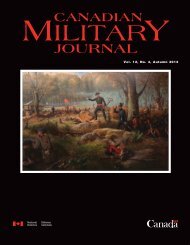Create successful ePaper yourself
Turn your PDF publications into a flip-book with our unique Google optimized e-Paper software.
of radar used. 24 Further reports clarified what radar sets<br />
could provide what specific coverage and detection<br />
capabilities. Depending upon the type of set, contact could<br />
be made from between 20 and 85 miles range. Balloon<br />
echoes were observed to be the same in general appearance<br />
as normal aircraft echoes, “except for a lower signal-to-noise<br />
ratio and a lower rate of fluctuation.” 25 All these reports<br />
were based upon data provided from tests conducted<br />
by the United States Army and the USN.<br />
The RCAF also possessed aircraft with airborne<br />
radar that could possibly be used to detect the balloons,<br />
mainly the Lockheed Venturas, which were used for<br />
coastal patrols. However, early estimates suggested that<br />
the airborne detection of balloons would be, at best, possible<br />
at a maximum range of four<br />
miles, 26 and at a subsequent<br />
WAC meeting, held to share<br />
information on the balloons,<br />
this was revised downwards to<br />
two miles. At this same meeting,<br />
a senior member of the command<br />
Operational Research Section<br />
expressed his doubt about the<br />
credibility of reports indicating<br />
that balloons had been detected<br />
by ground-based and shipborne<br />
radars at ranges up to 130 miles. 27<br />
Overall, the question of radar<br />
detection of the balloons was<br />
not clearly resolved, and the<br />
specific range capabilities were<br />
never defined for any particular<br />
radar set. The results obtained,<br />
as will be noted later, bear<br />
out this lack of clarity.<br />
opinion that Liberators were best suited. 28 Thankfully,<br />
the number of balloons and major balloon components<br />
being recovered intact rose throughout February, negating<br />
the requirement to request volunteers for what would have<br />
been a highly interesting mission, to say the least.<br />
The issue of civil-military cooperation was one that<br />
WAC did not have to face. By the time the balloons<br />
became a serious concern, the JSC decided that it would<br />
be the army’s responsibility to brief civil authorities on<br />
the balloons and to seek their assistance. Another issue<br />
that required resolution was involvement of civilian pilots.<br />
On the coast, there were not only Canadian commercial<br />
airlines and bush pilots, but also transiting American<br />
airliners heading to or returning from Alaska. Pacific<br />
<strong>HISTORY</strong><br />
Along with the issue of<br />
detecting the balloons was the<br />
question of their recovery.<br />
During the early stages of the<br />
threat, few were obtained. While<br />
recovery of an intact balloon<br />
could provide significant<br />
intelligence, the problem was an<br />
on-board detonator, designed to<br />
blow up the balloon once it<br />
descended through 20,000 feet.<br />
The WAC solution was to<br />
develop a plan whereby an<br />
aircraft would snag a balloon<br />
above this altitude, bring the<br />
balloon and hanging apparatus<br />
onboard the capturing aircraft<br />
and defuse the detonator before<br />
descending and returning to<br />
base. Consideration had been<br />
given to the use of Mosquito,<br />
Mitchell and Liberator aircraft<br />
for use in the snagging operation,<br />
and the engineers arrived at the<br />
This balloon recovered at Oxford Lake, MB, gives an idea of the size. The shrouds for the chandelier are<br />
laid out to the right.<br />
Author’s collection PA20330<br />
Summer 2005 ● Canadian Military Journal 63





